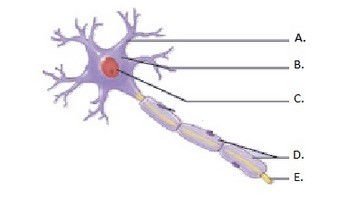Small changes in ________ will have a large impact on the heart's pumping effectiveness, while large changes in ________ do not impact the effectiveness much.
A. contractility; afterload
B. afterload; preload
C. preload; afterload
D. afterload; contractility
E. contractility; preload
Answer: C
You might also like to view...
The optic chiasm:
A) is in the orbit. B) refers to the central artery of the retina's crossing of the subarachnoid space. C) refers to partial splitting of the optic nerve fibers from each side to form the right and left optic tracts. D) refers to the missing field in visual field deficits. E) occurs in the lateral geniculate body.
 This is a diagram of a multipolar neuron. What does "B" represent?
This is a diagram of a multipolar neuron. What does "B" represent?
A. Glia cells B. Cell body of neuron C. Nucleus of neuron D. Axon E. Dendrite
Answer the following questions true (T) or false (F)
1. Stratified epithelium does not line areas where transcellular transport is required. 2. The apical plasma membranes of simple squamous epithelial cells are often folded into microvilli, which increases their surface area for absorption. 3. Stratified squamous epithelium is composed of multiple layers of flattened cells.
If the body experiences a drop in volume or blood pressure:
A) aldosterone stimulates the sweat glands, resulting in diaphoretic skin. B) adrenocorticotropic hormone causes a reduction in the secretion of cortisol. C) aldosterone secretion stimulates the kidneys to reabsorb sodium from the urine. D) catecholamine release inhibits the conversion of glycogen to glucose in the liver.